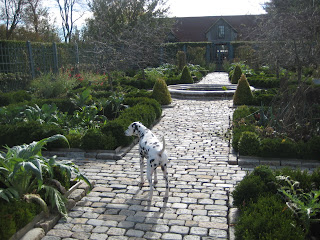The Ruin Garden at Teixeira Park has had five years to settle down and fill in. The dozen Malus 'Prariefire' trees along the sidewalk have gotten larger and fruited well. The theme has always been to be a wild garden, attracting birds and butterflies. A common complaint was that the garden felt isolated in the park and the suggestion was to add plantings on the outside of the granite walls of the Ruin Garden to soften them. My thought has always been that as the granite ages and the plants spill out, the garden will mature and its hidden nature will beckon visitors to enter and explore the garden; that being partially concealed was part of the allure.
But after careful consideration, we decided to plant the two triangular areas formed by the pathways at each end of the park. The East end is full sun and the West end is partial shade. I wanted to continue the wild theme and the paths, like the granite walls in the Ruin garden, made the boundaries very clear, which from a maintenance perspective is a good thing. We would now have three related gardens with overlapping plant lists that would talk to each other and create a repetition of gardens over the entire park as seen from the road. Hopefully the Ruin Garden wouldn't feel isolated, but rather, integrated into the landscape.
The Ruin Garden at Teixeira Park
Waking toward the West Garden from the Ruin Garden
The Part-Shade West Garden at Teixeira Park
The Sidewalk Looking toward the East Garden--Malus 'Prariefire' to the right
The East Garden at Teixeira Park
I have spent many hours studying Piet Oudolf's work in books and have seen three of his designs in person: the Glasshouse Borders at Wisley in England, The High Line and the Gardens of Remembrance in Manhattan. I was particularly interested in his "layered" approach to planting that Noel Kingsbury describes in the book Landscapes in Landscapes. The first layer is the "martix planting of ground-covering, relatively low growing plants. The next layer is the "island plants where irregularly shaped beds are planted with a mixture of grasses (and in my case, also perennials) for a late-summer-to-winter period of interest." The final layer is "the scatter plants, taller species, often colorful or with distinct structure." We also added trees and shrubs with colorful fruit and bulbs for interest in the early spring. Below is the plant list. Time will tell if our planting will be successful.
The East Garden Plant List
Trees/Shrubs
Viburnum dentatum 'Blue Muffin'
Matrix Planting
Sesleria autumnalis
Heuchera villosa 'Autumn Bride'
Aster macrophyllus
Island Plants
Helianthus occidentalis
Liatris ligulistylis
Monarda fistulosa
Solidago speciosa
Sporobolus heterolepsis
Solidago rigida
Scatter Plants
Eupatorium purpureum
Helianthus salicifolius
Sorghastrum nutans
Silphium perfoliatum
Bulbs
Camassia leichtlinii 'Blue Danube'
Chionodoxa sardensis
Tulipa sylvestris
The West Garden Plant List
Trees/Shrubs
Cornus mas
Matrix Planting
Sesleria autumnalis
Heuchera villosa 'Autumn Bride'
Aster macrophyllus
Island Plants
Helianthus stromusus
Aster divaricatus
Sporobolus heterolepsis
Scatter plants
Eupatorium purpureum
Aruncus aethusifolia
Aralia racemosa
Bulbs
Camassia leichtlinii 'Blue Danube'
Chionodoxa sardensis
Hyacinthoides non-scripta
Tulipa sylvestris




































































